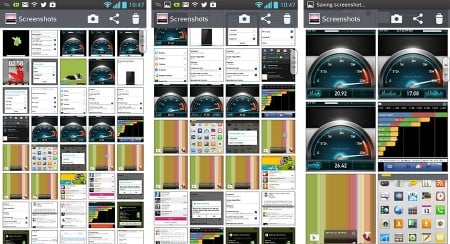The look of the smartphone is one place we can start from, and this is certainly a phone that is designed to be a simple and elegant machine.
For the most part, it succeeds, offering a look that is truly minimalist with black on each side, some silver trim, and an almost holographic pixelated look on the back of the device.
In the hands, it’s a comfortable fit, and features some simple curves rounding out an otherwise rectangular design. While it doesn’t flow into the palm of the hand like some devices, it is easy to grip, though make sure you do, because with a glass front and back, it can be a little slippery.
One area that LG has really pushed hard with is in how you can change things, with an immense amount of customisation on offer. We can see why the company calls it a “superphone,” because it just has so much versatility, and it’s almost like LG looked at the state of Android overlays and decided to do it from scratch, rewriting the books on what should and shouldn’t be done.
As such, you can share folders over wireless networking, turn off the lights at the soft buttons on the bottom of the device, fix the aspect ratio for various apps because of the different sized screen LG uses, pick between multiple system fonts, change the desktop icons easily with pretty much any image, pick a different animation for not just homescreen swiping but also lock screen unlocking, make the homescreens go round and round in a circle, run the homescreen in landscape mode, snooze an alarm or pause a video by flipping the phone over, optimise the processor to control battery life, edit the order and visibility of shortcuts in the top dropdown bar, change the size of the menu app icons, and more.
That’s a lot of functionality, and if you’re one of those people that loves to play and set things up perfectly, this handset caters for you perfectly. It can also be used without customising all of these settings, but it’s nice knowing these “super” aspects are here.
In fact, there’s even more in there for zooming, with an ability to change text and image size in various apps – such as contacts and gallery – simply by zooming with your fingers, and it’s nice to see a common gesture applied to more than just getting up close with a picture.

LG has provided some wallpapers – a couple of them live and animated, even – as well as a backup application for making sure you have all those bits and pieces you need secure. Then there’s video editing, language translation, support, and even the ability to add multiple images to make a neato wallpaper that shows a different image per homescreen.
Using this last feature, you can take advantage of a zoom-in gesture and flick through the handset as if you were browsing a personal photo album, moving past the shortcuts and widgets on the homescreen and making them disappear, leaving you free to browse through your pictures as if it were a small photo album.
Jumping between various apps, the Snapdragon quad-core processor is no slouch, and it’s more than capable of running multiple programs.
Benchmarking shows that this phone performs well too, though didn’t seem to be as aggressive in raw power as the Sony Xperia Z, even though they run the same processor and amount of memory.
There’s also some great sound on offer, and we have to say that the Optimus G has one of the best loudspeakers on the market, and even pumps out some excellent audio over its headphone port.

The camera is a decent performer too, offering some stunning colours and impressive detail, thanks to the 13 megapixels on offer.
Some nifty features are present too, such as the ability to fire the camera off when you say a word with the “eee” sound – “cheese” or “whiskey” – as well as a preempting camera mode that continually buffers itself and fires even before you hit the shutter, so you don’t miss a smile and try to dodge the blinks.












Bought this phone yesterday for $388 at Jb Hifi and it came with a wireless adapter to connect to your Tv, the phone is awesome, tested it in sunlight and its much better than my old S2, browsing, switching folders is super quick and the quadbeat headphones are amazing. If you can get this for under $400 it is a steal!
Wow. That is an excellent price.
I did the same!!
GREAT phone. And the extra Wireless Display Adapter (Miracast) .. man $388 is so much value!
I only wish the devs supported it more on xda, but oh well! Great upgrade from my Nexus S.
wow that is such a good price you got it from jbhi fit, kogan haven’t got any lower than $500, did you negotiate?
Fantastic review by the author! He touched on topics of interest, yet managed to keep it concise. Wish there were not so many ads on this page though!